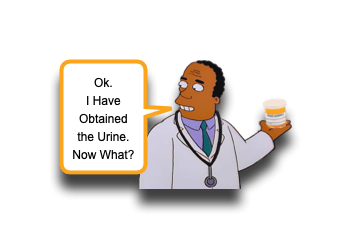Urinary Tract Infection (UTI) Algorithm

It often seems that we are on the search for the omnipresent Urinary Tract Infection (UTI) in the Pediatric ED. “You have fever? Let’s check the urine.” “You have belly pain? Let’s check the urine.” “You think your urine smells funny? Let’s check the urine.” Urinalysis, it would appear, is the most useful of tests (or, at least it is the “easiest” to order). Without a doubt, UTI is a prevalent condition and warrants our contemplation (and, thus has been contemplated often in the Morsels (UTI and Concurrent Meningitis, Antibiotics for UTI, UTI and Duration of Fever, UTI). Surprisingly, the topic is a little more complex than merely ordering an Urinalysis. Fortunately, our friends at AAP Section on EM has developed a tool that we may us to help navigate through this complicated topic. Let’s take a moment to review their Urinary Tract Infection (UTI) Algorithm:
UTI: Basics
- UTI is the 2nd most common bacterial infection, following AOM.
- UTI is the most common serious bacterial infection in febrile infants/children.
- 10% of all febrile children
- 7% of febrile new-borns with high rates of concurrent bacteremia
- Uncircumcised male infants < 3 months of age and females < 12 months have the highest prevalence of UTI
- UTI can become a big problem in children!
- Pyelonephritis
- Chronic UTIs
- Chronic renal insufficiency
- Hypertension
- Urosepsis
UTI: AAP SOEM Algorithm
Below is a useful approach that the American Academy of Pediatric’s Section On Emergency Medicine proposes. It is a nice synopsis of what has been previously noted in the Ped EM Morsels and is a useful clinical aid.
UTI-Algorithm-FINAL-12.18Moral of the Morsel
- Know who’s at Risk. Having a fever for 36 seconds before coming to the ED is NOT one of them!
- What’s the Mico? The dip alone may not be enough to make the diagnosis in young children (<24 months).
- It’s Ok to Wait. If the results are not conclusive, don’t force the issue. Wait the culture results and explain this plan to the patient and patient’s family.


This is great! Just out of curiosity why does a clean catch require a cath after if it is dirty? If proper cleaning is done of the GU area prior to clean catch it would seem as though a culture could be sent on it.
Thanks!!
A sample that is obtained via clean catch canNOT be used for reliable culture results. Even if one were to clean optimally, the results would be suspect.
If the clean catch U/A is completely normal, then you can assume that the culture would be negative. If, on the other hand, the clean catch U/A was abnormal, you can assume the culture would be positive, so a cath specimen is required.
Hope that that helps,
Sean